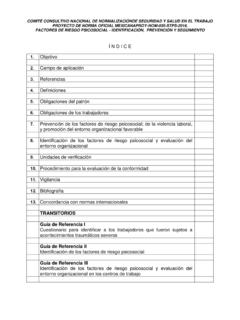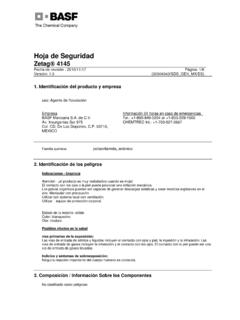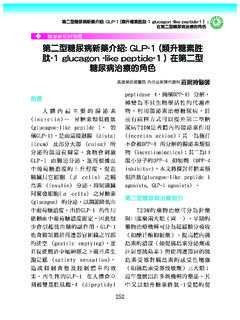Transcription of Safety Data Sheet: Liquid Chlorine/Cloro Liquido
1 Petroqu mica Mexicana de Vinilo, de 1 S/N Complejo Petroqu mico Pajaritos96400 CoatzacoalcosMexico Telephone: (921) 211 71 00 Telefax: (921) 211 71 90e-mail: SECTION 1: identifierIdentification of the substanceLiquid Chlorine/Cloro LiquidoCAS number7782-50-5 Alternative number(s) identified uses of the substance or mixture and uses advised againstRelevant identified usesGeneral of the supplier of the Safety data sheete-mail (competent (Reyna Pat Espadas) telephone numberEmergency information service 01-800-712-1275 / 01 (921) 211 7100 Ext. number is only available during the follow-ing office hours: Mon-Fri 09:00 AM - 05:00 PM,For Emergencies in Transport:In USA CHEMTREC 1-800-424-9300In M xico CENACOM 01-800-00-413-00In M xico SETIQ 01-800-00-214-00 SECTION 2: Hazard(s) of the substance or mixtureClassification acc.)
2 To OSHA "Hazard Communication Standard" (29 CFR )SectionHazard classCat-egoryHazard class andcategoryHazard toxicity (inhal.)2 Acute Tox. corrosion/irritation2 Skin Irrit. eye damage/eye irritation2 AEye Irrit. target organ toxicity - single exposure1 STOT SE target organ toxicity - single exposure (respirat-ory tract irritation)3 STOT SE target organ toxicity - repeated exposure1 STOT RE to the aquatic environment - acute hazard1 Aquatic Acute to the aquatic environment - chronic hazard1 Aquatic Chronic 1H410 Safety Data Sheetacc. to 29 CFR App DLiquid Chlorine/Cloro LiquidoVersion number: GHS version of: 2016-10-07 (GHS 1)Revision: 2016-10-11 United States: enPage: 1 / 13 For full text of abbreviations: see SECTION 16.
3 Delayed or immediate effects can be expected after short or long-term exposure. Spillage and fire water can causepollution of watercourses. According to the results of its assessment, this substance is not a PBT or a vPvB. According to the results of its assessment, this substance is not a PBT or a vPvB. The most important adverse physicochemical, human health and environmental effectsAdditional elementsLabelling acc. to OSHA "Hazard Communication Standard" (29 CFR ) Labeling:- Signal worddanger- Pictograms - Hazard skin serious eye if cause respiratory damage to damage to organs through prolonged or repeated toxic to aquatic life with long lasting Precautionary statementsP260Do not breathe dust/fume/gas/mist/ +P340IF INHALED: Remove person to fresh air and keep comfortable for +P351+P338IF IN EYES: Rinse cautiously with water for several minutes.
4 Remove contact lenses, if presentand easy to do. Continue +P311IF exposed or concerned: Call a POISON call a POISON +P233 Store in a well-ventilated place. Keep container tightly hazardsResults of PBT and vPvB assessmentSECTION 3: Composition/information on of substanceLiquid Chlorine/Cloro LiquidoIdentifiersCAS No7782-50-5 Molecular formulaCl2 Molar g/molSafety Data Sheetacc. to 29 CFR App DLiquid Chlorine/Cloro LiquidoVersion number: GHS version of: 2016-10-07 (GHS 1)Revision: 2016-10-11 United States: enPage: 2 / 13Do not leave affected person unattended. Remove victim out of the danger area. Keep affected person warm, stilland covered. Take off immediately all contaminated clothing.
5 In all cases of doubt, or when symptoms persist, seekmedical advice. In case of unconsciousness place person in the recovery position. Never give anything by mouth. If breathing is irregular or stopped, immediately seek medical assistance and start first aid actions. In case of respirat-ory tract irritation, consult a physician. Provide fresh air. Wash with plenty of soap and water. Remove contact lenses, if present and easy to do. Continue rinsing. Irrigate copiously with clean, fresh water for atleast 10 minutes, holding the eyelids apart. Rinse mouth with water (only if the person is conscious). Do NOT induce vomiting. Symptoms and effects are not known to date. none Water spray, Alcohol resistant foam, BC-powder, Carbon dioxide (CO2) Water jet Nitrogen oxides (NOx) In case of fire and/or explosion do not breathe fumes.
6 Co-ordinate firefighting measures to the fire surroundings. Do not allow firefighting water to enter drains or water courses. Collect contaminated firefighting water separately. Fight fire with normal precautions from a reasonable distance. SECTION 4: First-aid of firs- aid measuresGeneral notesFollowing inhalationFollowing skin contactFollowing eye contactFollowing important symptoms and effects, both acute and of any immediate medical attention and special treatment neededSECTION 5: Fire-fighting mediaSuitable extinguishing mediaUnsuitable extinguishing hazards arising from the substance or mixtureHazardous combustion for firefightersSafety Data Sheetacc. to 29 CFR App DLiquid Chlorine/Cloro LiquidoVersion number: GHS version of: 2016-10-07 (GHS 1)Revision: 2016-10-11 United States: enPage: 3 / 13 Remove persons to Safety .
7 Wear breathing apparatus if exposed to vapors/dust/aerosols/gases. Keep away from drains, surface and ground water. Retain contaminated washing water and dispose of it. Covering of drains Wipe up with absorbent material ( cloth, fleece). Collect spillage: Sawdust, Kieselgur (diatomite), Sand, Universalbinder Use of adsorbent materials. Place in appropriate containers for disposal. Ventilate affected area. Hazardous combustion products: see section 5. Personal precautions: see section 8. Incompatible materials: see sec-tion 10. Disposal considerations: see section 13. Use local and general ventilation. Use only in well-ventilated areas. Wash hands after use. Do not eat, drink and smoke in work areas.
8 Remove contaminated clothing and protectiveequipment before entering eating areas. Never keep food or drink in the vicinity of chemicals. Never place chemicalsin containers that are normally used for food or drink. Keep away from food, drink and animal feedingstuffs. Keep any substance that emits harmful vapors or gases in a place that allows these to be permanently extracted. Only packagings which are approved ( acc. to the Dangerous Goods Regulations) may be used. See section 16 for a general overview. SECTION 6: Accidental release precautions, protective equipment and emergency proceduresFor non-emergency personnelFor emergency and material for containment and cleaning upAdvices on how to contain a spillAdvices on how to clean up a spillAppropriate containment techniquesOther information relating to spills and to other sectionsSECTION 7: Handling and for safe handlingRecommendations- Measures to prevent fire as well as aerosol and dust generationAdvice on general occupational for safe storage, including any incompatibilities- Ventilation requirements- Packaging end use(s) Safety Data Sheetacc.
9 To 29 CFR App DLiquid Chlorine/Cloro LiquidoVersion number: GHS version of: 2016-10-07 (GHS 1)Revision: 2016-10-11 United States: enPage: 4 / 13 General ventilation. SECTION 8: Exposure controls/personal parametersOccupational exposure limit values (Workplace Exposure Limits)Coun-tryName of agentCAS NoNotationIdentifi-erTWA[ppm]TWA[mg/m ]STEL[ppm]STEL[mg/m ]STEL[min]Ceil-ing-C[ppm]Ceil-ing-C[mg/m ]SourceUSchlorine7782-50-5 PEL1329 CFROSHAN otationCeiling-Cceiling value is a limit value above which exposure should not occurSTEL short-term exposure limit: a limit value above which exposure should not occur and which is related to a 15-minute peri-od unless otherwise specifiedTWAtime-weighted average (long-term exposure limit).
10 Measured or calculated in relation to a reference period of 8 hourstime-weighted averageHuman health valuesRelevant DNELs and other threshold levelsEndpointThresholdlevelProtection goal,route of exposureUsed inExposure mg/m human, inhalatoryworker (industry)chronic - local mg/m human, inhalatoryworker (industry)chronic - systemic effectsEnvironment valuesRelevant PNECs and other threshold levelsEnd-pointThresholdlevelOrganismEnv ironmental compart-mentExposure g/laquatic organismsfreshwatershort-term (single instance) g/laquatic organismsmarine watershort-term (single instance) mg/lmicroorganismssewage treatment plant(STP)short-term (single instance) mg/kg(top) predatorswatershort-term (single instance) g/laquatic organismswaterintermittent controlsAppropriate engineering controlsSafety Data Sheetacc.














